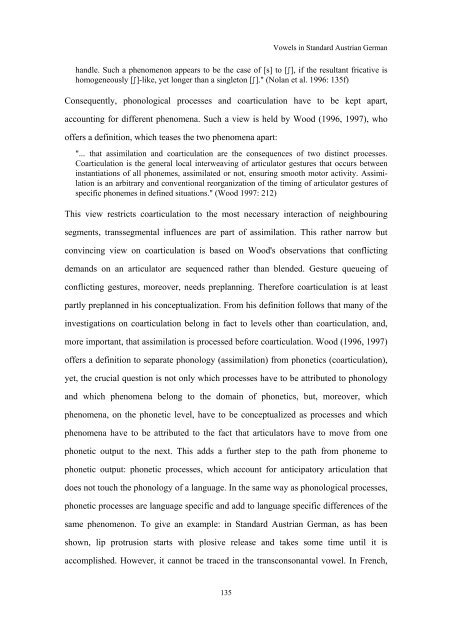VOWELS IN STANDARD AUSTRIAN GERMAN - Acoustics ...
VOWELS IN STANDARD AUSTRIAN GERMAN - Acoustics ...
VOWELS IN STANDARD AUSTRIAN GERMAN - Acoustics ...
You also want an ePaper? Increase the reach of your titles
YUMPU automatically turns print PDFs into web optimized ePapers that Google loves.
135<br />
Vowels in Standard Austrian German<br />
handle. Such a phenomenon appears to be the case of [s] to [S], if the resultant fricative is<br />
homogeneously [S]-like, yet longer than a singleton [S]." (Nolan et al. 1996: 135f)<br />
Consequently, phonological processes and coarticulation have to be kept apart,<br />
accounting for different phenomena. Such a view is held by Wood (1996, 1997), who<br />
offers a definition, which teases the two phenomena apart:<br />
"... that assimilation and coarticulation are the consequences of two distinct processes.<br />
Coarticulation is the general local interweaving of articulator gestures that occurs between<br />
instantiations of all phonemes, assimilated or not, ensuring smooth motor activity. Assimilation<br />
is an arbitrary and conventional reorganization of the timing of articulator gestures of<br />
specific phonemes in defined situations." (Wood 1997: 212)<br />
This view restricts coarticulation to the most necessary interaction of neighbouring<br />
segments, transsegmental influences are part of assimilation. This rather narrow but<br />
convincing view on coarticulation is based on Wood's observations that conflicting<br />
demands on an articulator are sequenced rather than blended. Gesture queueing of<br />
conflicting gestures, moreover, needs preplanning. Therefore coarticulation is at least<br />
partly preplanned in his conceptualization. From his definition follows that many of the<br />
investigations on coarticulation belong in fact to levels other than coarticulation, and,<br />
more important, that assimilation is processed before coarticulation. Wood (1996, 1997)<br />
offers a definition to separate phonology (assimilation) from phonetics (coarticulation),<br />
yet, the crucial question is not only which processes have to be attributed to phonology<br />
and which phenomena belong to the domain of phonetics, but, moreover, which<br />
phenomena, on the phonetic level, have to be conceptualized as processes and which<br />
phenomena have to be attributed to the fact that articulators have to move from one<br />
phonetic output to the next. This adds a further step to the path from phoneme to<br />
phonetic output: phonetic processes, which account for anticipatory articulation that<br />
does not touch the phonology of a language. In the same way as phonological processes,<br />
phonetic processes are language specific and add to language specific differences of the<br />
same phenomenon. To give an example: in Standard Austrian German, as has been<br />
shown, lip protrusion starts with plosive release and takes some time until it is<br />
accomplished. However, it cannot be traced in the transconsonantal vowel. In French,












